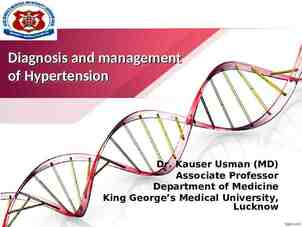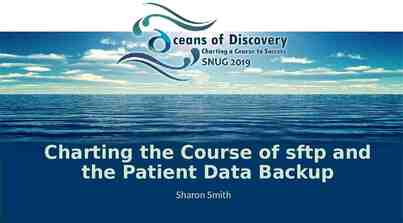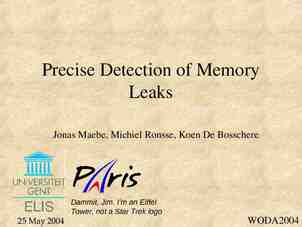Exam Prep: Microsoft Technology Associate 98-366:
40 Slides709.78 KB
Exam Prep: Microsoft Technology Associate 98-366: Networking Fundamentals
Meet the Presenters Christopher Chapman, MCT Content Project Manager, Microsoft Learning Background IT manager and implementer focused on deploying, maintaining and optimizing networks of all sizes IT Consulting projects include Custom SharePoint for Microsoft IT, Netware/Notes migration to AD/Exchange, Transition to centralized management (250 clients) Instructor and Director of Instruction Multiple Microsoft and other industry certifications (MCP, MCTS, MCSA, MCSE, MCT) Contact [email protected] @ChristopherMSL
Meet the Presenters Background Taught the Microsoft MCSE and the Novell CNE certifications, and worked as a network consultant for almost 10 years Courseware Author for MS Learning Content developer for Remote Desktop Virtualization at Microsoft for the last 5 years Contact [email protected] Thomas Willingham Content Developer, Cloud and Enterprise
Course Topics Network Fundamentals 01 02 03 04 05 06 07 08 Understanding Local Area Networking Defining Networks with the OSI Model Understanding Wired and Wireless Networks Understanding Internet Protocol (IP) TCP/IP Tools Network Services Understanding Wide Area Networks Defining Network Infrastructure and Security
Setting Expectations Target Audience IT Help Desk staff interested in moving into Network/Systems Administration Anyone interested in learning more about networking Suggested Prerequisites/Supporting Material Exam 98-349: Windows Operating System Fundamentals
Understanding Local Area Networking Module 1
Objectives Skills/Concepts Objective Domain Description Objective Domain Number Examining Local Area Understand local area 1.2 Networks, Devices networks (LANS) and Data Transfers Identifying Network Topologies and Standards Understand network 1.5 topologies and access methods
Network components and Terminology Data Node Switch Router Client Server Media Transport Protocol Bandwidth Peer Network adapter Hub
Local Area Network A Local Area Network (LAN) is group of computers confined to a small geographic area, such as a single building A LAN is a group of computers or devices that share a common communication medium, such as cabled or wireless connections
Networks Networks are used to exchange data Reasons for networks include Sharing information Communication Organizing data
Network Documentation Network documentation helps describe, define, and explain the physical and logical method for connecting devices The documentation phase occurs before a network is built, or when changes are made to the network Microsoft Visio is a tool that can be used to document networks
Hub A Hub is the most basic central connecting device Hubs enable computers on a network to communicate A host sends data to the hub. The hub sends the data to all devices connected to the hub
Switch Switches work the same was as a hub, but they can identify the intended recipient of the data Switches can send and receive data at the same time
Router Routers enable computers to communicate and allow communication between two networks – such as your home network and the Internet This communications link between the one network and the other is where the LAN ends Interne t 24.136.72. 110 192.168. 1.1
Network Adapter and RJ45 Patch Cable A network adapter, also known as a network interface card (NIC), is the hardware device that enables you to send and receive from your computer RJ45 is the most common type of network adapter connection A network adapter can connect to the network by using cable (wired) or by air (wireless)
Wireless Access Point The wireless access point (WAP) acts as the central connecting device for the network Wireless networks can consist of many types of devices other than traditional PCs: Smart phones PDAs Tablet computers Micro computers PCs and laptops equipped with wireless network adapters can connect to these networks as well
Demo Device Manager Showing Network Adapters Network Adapter Properties IP Address
Serial Data Transfer Serial data transfer is the transfer of one bit at a time—in other words, transfer in a single-bit stream, like a one lane highway On the network cable, data travels in a single bit stream
Data Transfer Rate Data transfer rate defines the maximum bits per second (bps) that can be transmitted over a network Rated in bits, and signified with a lowercase b (for example, 10 Mbps) The lowercase b differentiates this unit from data that is stored on a hard drive, which uses an upper case B that stands for bytes (for example 10 MB) Types of Transfers Broadcast sends data to every other host on the network Unicast sends data to a specific host
IP Address Most every computer and many other devices have an Internet Protocol (IP) address An IP address uniquely identifies your device and the associated network and allows each device to send and receive information A typical example of an IPv4 address would be 192.168.1.1 Every IP address is broken down into two parts by a subnet address Network ID 192.168.1 Host ID 1
LAN Computers and other devices are connected using copper-based twisted-pair cables or wireless equipment
Virtual LAN A virtual LAN (VLAN) is a group of hosts with a common set of requirements that communicate as if they were connected together in a normal fashion on one switch, regardless ofPorttheir physical location. Port 1: 6: VLAN1 Port 2: VLAN1 Port 3: VLAN2 Port 4: Port 5: VLAN1 VLAN1 Port 7: VLAN2 Port 8: VLAN1 Port 9: Port 10:
Network Topology A network topology defines the physical connections of hosts in a computer network. There are several types of physical topologies including: Bus Ring Star Mesh Tree
Star Topology Most Common topology Each computer is individually wired to a central connecting device (hub, switch or SOHO router) with twistedpair cabling
Mesh Topology Every computer connects to every other computer; no central connecting device is needed.
Ring Topology In a LAN environment, each computer is connected to the network using a closed loop Used by Token Ring and Fiber Distributed Data Interface (FDDI)
Token Ring A Token Ring network sends data logically in a ring fashion, meaning that a token goes to each computer, one at a time, and continues on in cycles Physically Token Ring computers are connected in a star fashion Namely, all computers in a Token Ring network are connected to a central connecting device known as a Multistation Access Unit (MAU or MSAU)
Ethernet Institute of Electrical and Electronics Engineers (IEEE) standard (802.3) that defines how information is sent and received between network adapters, hubs, switches, and other devices Ethernet is the de facto standard and is the most widelyinstalled local area network technology Common types of Ethernet include: 802.3u or Fast Ethernet that runs at 100 Mbps 802.3ab or Gigabit Ethernet
Frames Computers on Ethernet networks communicate via frames A frame is a sequence of bits containing a detectable beginning and end of a packet in the stream of bits A frame is a data packet residing on Layer 2 of the OSI model frame preamble (8 bytes) data crc (4 bytes)
Centralized Computing Computing is done at a central location using terminals that are attached to this main system Mainframes are a powerful computer and the rest of the devices connected to the computer are known as terminals (or dumb terminals) Each terminal consisted solely of a keyboard and display with no processing power
Client/Server Model The client/server model is an architecture that distributes applications between servers and client computers Server: System that provides services such as Windows Server 2008 R2 Client: Device that requests services such as Windows 7
Peer-to-Peer Networking Peer-to-peer networking distributes applications or workloads between computers Peers are both service providers and service requestors
Distributed Computing Distributive computing includes both client-server and peer-to-peer networks Every device or workstation has its own processing power
Remote Desktop Services and Remote Sessions Centralized computing has made a comeback of sorts. Remote Desktop Services and remote sessions to computers are based off of the centralized computing model Thin-client computers do not have a hard drive and store an operating system in RAM, to be loaded up every time the device is turned on All other applications and data are stored centrally, this system is a blend of centralized and distributive computing
Servers More powerful computers that provide centralized services: File Print Database Network controller Messaging/Email Web
Client and Server Operating Systems Client Operating Systems Server Operating Systems Windows 8 Windows Server 2012 Windows 7 Windows Server 2008 R2 Windows Server 2008 Windows Vista Windows XP Windows Server 2003 Windows 2000 Professional Windows 2000 Server Windows NT 4.0 Workstation Windows ME/98/95 Windows NT 4.0 Server
P2P Peer-to-peer or P2P has recently taking on an additional meaning P2P can also refer to file sharing networks Examples of file sharing networks Napster Gnutella G2 Other technologies also take advantage of P2P file sharing: Skype VoIP Cloud computing
Summary Understand local area networks (LANs), including but not limited to LAN elements, design, perimeter networks, IP addressing, and LAN types Understand network topologies and access methods, including topologies such as star, mesh, and ring; Ethernet architecture; and the client-server and peer-to-peer networking models
Additional Resources & Next Steps Instructor-Led Courses 40033A: Windows Operating System and Windows Server Fundamentals: Training 2Pack for MTA Exams 98-349 and 98-365 (5 Days) 40349A: Windows Operating System Fundamentals: MTA Exam 98-349 (3 Days) 40032A: Networking and Security Fundamentals: Training 2-Pack for MTA Exams 98-366 and 98-367 (5 Days) 40366A: Networking Fundamentals: MTA Books Exam 98-366 Exams & Exam 98-366: MTA Networking Certification Fundamentals s (Microsoft Official Exam 98-366: Academic Course) Networking Fundamentals
2012 Microsoft Corporation. All rights reserved. Microsoft, Windows, Windows Vista and other product names are or may be registered trademarks and/or trademarks in the U.S. and/or other countries. The information herein is for informational purposes only and represents the current view of Microsoft Corporation as of the date of this presentation. Because Microsoft must respond to changing market conditions, it should not be interpreted to be a commitment on the part of Microsoft, and Microsoft cannot guarantee the accuracy of any information provided after the date of this presentation. MICROSOFT MAKES NO WARRANTIES, EXPRESS, IMPLIED OR STATUTORY, AS TO THE INFORMATION IN THIS PRESENTATION.













































